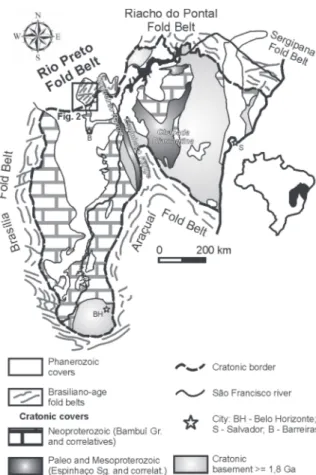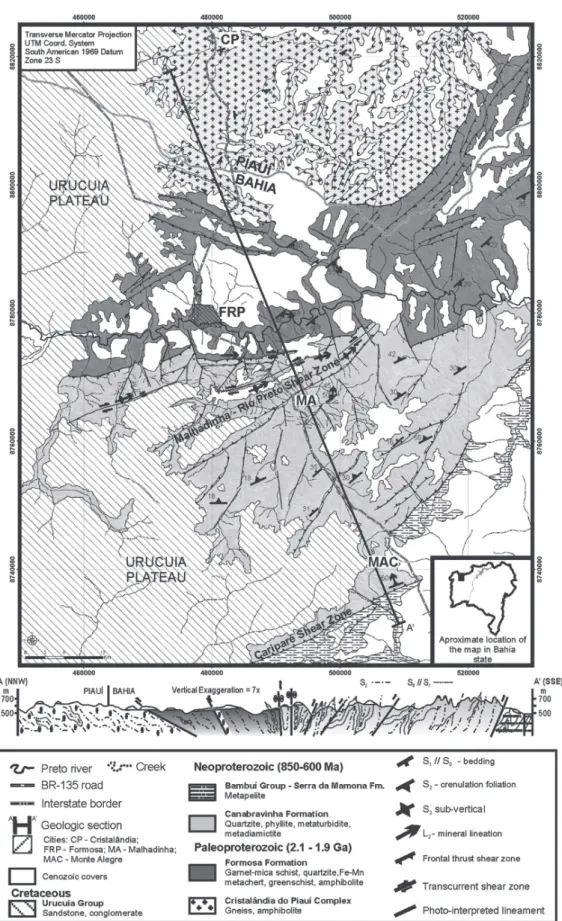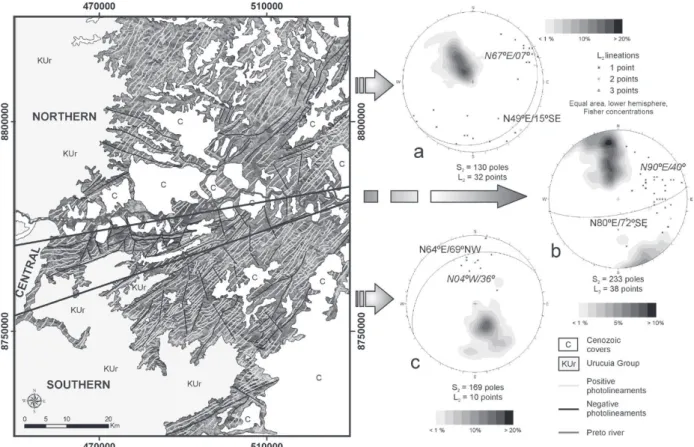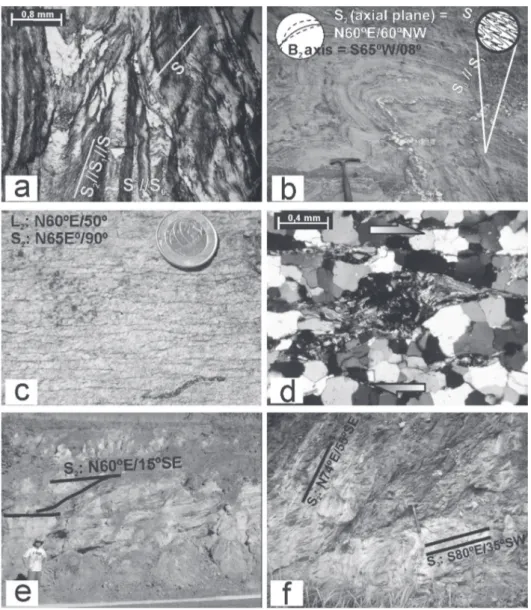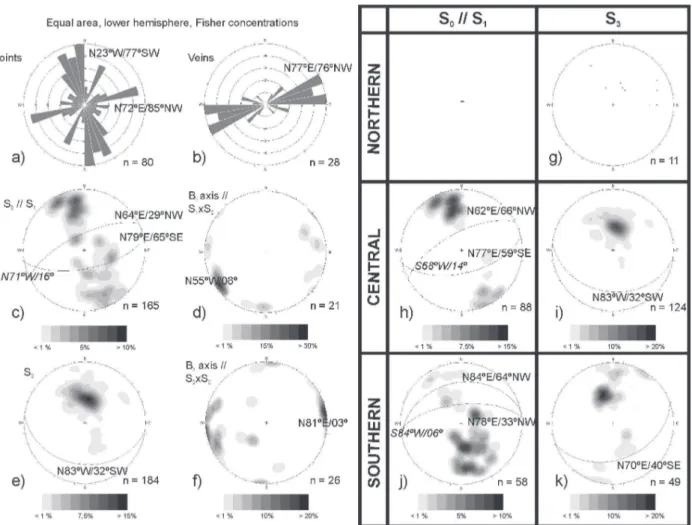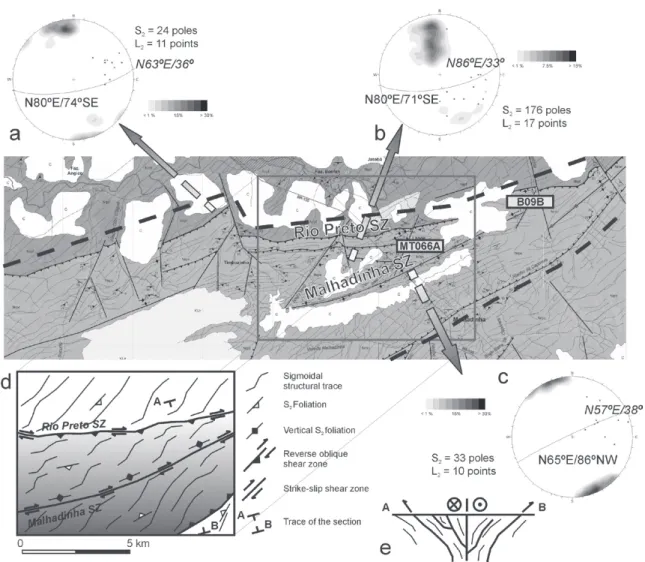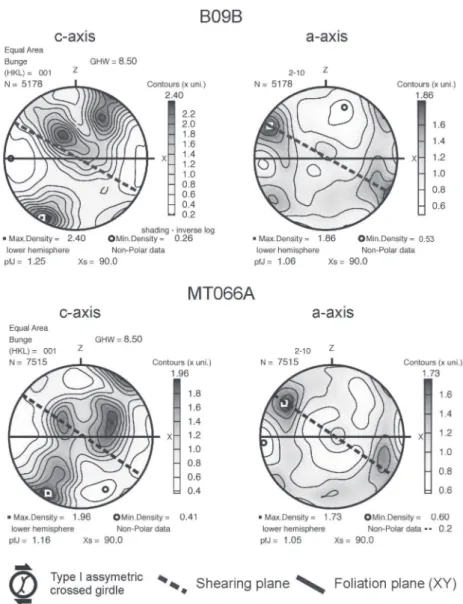(Annals of the Brazilian Academy of Sciences)
Printed version ISSN 0001-3765 / Online version ISSN 1678-2690 www.scielo.br/aabc
Structural analysis of the Rio Preto fold belt (northwestern Bahia / southern Piauí), a doubly-vergent asymmetric fan developed during the Brasiliano Orogeny
FABRÍCIO A. CAXITO1, ALEXANDRE UHLEIN1, LUIZ F.G. MORALES2,
MARCOS EGYDIO-SILVA3, JULIO C.D. SANGLARD1, TATIANA G. DIAS1 and MONICA C.O. MENDES1
1
Departamento de Geologia, Instituto de Geociências, Universidade Federal de Minas Gerais, Av. Antônio Carlos, 6627, 31270-901 Belo Horizonte, MG, Brasil
2Géosciences Montpellier, UMR 5243 - CC 60, Université Montpellier 2, Place E. Bataillon,
34095 Montpellier cedex 5, France
3
Departamento de Mineralogia e Geotectônica, Instituto de Geociências/ USP, Rua do Lago, 562, 05508-080 São Paulo, SP, Brasil
Manuscript received on April 29, 2013; accepted for publication on December 10, 2013
ABSTRACT
The Rio Preto fold belt borders the northwestern São Francisco craton and shows an exquisite kilometric doubly-vergent asymmetric fan structure, of polyphasic structural evolution attributed exclusively to the Brasiliano Orogeny (~600-540 Ma). The fold belt can be subdivided into three structural compartments: The Northern and Southern compartments showing a general NE-SW trend, separated by the Central Compartment which shows a roughly E-W trend. The change of dip of S2, a tight crenulation foliation which is the main structure of the fold belt, between the three compartments, characterizes the fan structure. The Central Compartment is characterized by sub-vertical mylonitic quartzites, which materialize a system of low-T strike slip shear zones (Malhadinha – Rio Preto Shear Zone) crosscutting the central portion of the fold belt. In comparison to published analog models, we consider that the unique structure of the Rio Preto fold belt was generated by the oblique, dextral-sense interaction between the Cristalândia do Piauí block to the north and the São Francisco craton to the south.
Key words: Brasiliano Orogeny, doubly-vergent fan, Rio Preto fold belt, São Francisco craton, structural analysis.
Correspondence to: Fabrício de Andrade Caxito E-mail: boni@ufmg.br
INTRODUCTION
Doubly-vergent asymmetric fans are an unusual and interesting feature of many thrust-and-fold belts around the world (e.g. Koons 1990, Willett et al. 1993, McClay and Whitehouse 2004, McClay et al. 2004). The structural analysis and understanding of the causes that lead to the development of such structures is important for models of tectonic
evolution within orogenic and foreland areas, as
well as for the exploration of hydrocarbon fields
which are contained within these belts.
and-fold belts that surround the São Francisco craton. In this paper, we aim to contribute with new structural data collected within this area, whose analysis will further be used as a background for the understanding of the causes of development of this structure within the context of the Brasiliano Orogeny (~600-540 Ma).
by Neoarchaean (~2.8 Ga) to Paleoproterozoic (~2.0-1.9 Ga) biotite-gneiss and amphibolite (Egydio-Silva et al. 1989, Caxito et al. 2012a). The Formosa Formation is composed by garnet-mica schist, quartzite, metachert, greenschist and epidote-amphibolite intercalations, the latter dated at 1,961 ± 11 Ma by LA-ICP-MS U-Pb zircon analysis (Caxito et al. 2012a), thus suggesting an Orosirian age for this unit. The Canabravinha Formation is a km-thick rift sequence composed by metagraywacke, metaturbidite, quartzite, phyllite, and metadiamictite intercalations. The maximum age of deposition of this sequence is around 850 Ma, according to the youngest detrital zircon popu lation dated by the U-Pb LA-ICP-MS method (Caxito et al. 2012a, Caxito et al. 2014). This unit might correlate with other diamictite-bearing units within and around the São Francisco craton (Caxito et al. 2012b).
All of the above stratigraphic units were subjected to greenschist facies metamorphism and deformation, which stacked the metasedimentary sequences together through tectonic contacts such as oblique and reverse faults (Figure 2). Coarse biotite and muscovite grains from all three units, parallel to the main foliation of the fold belt (S2),
yielded K-Ar ages around 600-540 Ma (Egydio-Silva 1987). This geochronological data indicates a Neoproterozoic (Brasiliano-age) development for the main structure throughout the fold belt.
MATERIALS AND METHODS
Three types of aerial imagery were used in the stage of photogeological interpretation which preceded field work: Nine stereographic pairs (lateral aerial view photos) in the 1:70.000
scale from a 1968 flight; LANDSAT-7 2000 30-m
resolution radar imagery; and a digital terrane elevation model generated using Golden Software Surfer 8©, using topographic data from the SRTM mission (http://seamless.usgs.gov), with a resolution of 3’’ (90 meters).
Figure 1 - The São Francisco craton and surrounding fold belts. The rectangle indicates the location of Fig. 2. Modified from Alkmim (2004).
For the microstructural description of the rock units, 50 thin sections from selected samples were
made. Samples were oriented and collected in the field
according to the procedures of Passchier and Trouw (1996). The lattice preferred orientation (LPO) analysis of two quartzite oriented sections was performed at Université de Montpellier II, France, through the electron backscatter diffraction (EBSD) technique, using a JEOL JSM 5600 scanning electron microscope equipped with an Oxford Instruments/HKL Nordlys EBSD detector and Channel 5® software.
RESULTS
PHOTOLINEAMENT INTERPRETATION
A photolineament map of the area was developed through the analysis of aerial imagery, with
emphasis on planar and linear positive and negative features. According to the orientation of the photolineaments, the area can be subdivided into three sub-compartments: Northern, Central and Southern (Figure 3), separated by large (kilometric) negative lineaments interpreted as disruptive structures. The Northern and Southern compartments show a prevalent NE-SW structural trend, while the Central compartment shows an E-W trend.
The positive photolineaments show a strong correlation with the most penetrative metamorphic foliation (S2) throughout the area, and for this reason
in Figure 3 the pole stereograms for this structure are represented for each compartment, along with the respective L2 mineral and stretching lineations.
STRUCTURAL ACQUIS
Three secondary foliations are recognizable throug-hout the Rio Preto fold belt (Egydio-Silva 1987; Figure 4a). The main planar structure is a tight and penetrative, milimetrically spaced axial-plane crenulation foliation (S2), which passes gradatively,
from north to south, from a coarse schistosity in the Formosa Formation rocks, to a crenulation cleavage in the southern reaches of the Canabravinha
Formation, and then finally to a slaty cleavage in
the metapelites of the Serra da Mamona Formation, Bambuí Group. For each structural compartment, S2 shows a distinct modal maximum (Figure 3).
The development of S2 happened alongside quartz
dynamics recrystallization, muscovite, chlorite, almandine and spessartite blastesis. Thus, S2 is
closely related to the main metamorphic event of the Rio Preto fold belt. The L2 set represents
mineral lineations (mica, chlorite, amphibole, opaques) and stretching lineations (crystals and quartz aggregates) within the S2 planes. L2 presents
distinct attitudes for each structural compartment (Figure 3).
When the S2 planes are locally millimetricaly
spaced, a precedent foliation can be observed in the microlithons (S1//S0), showing microfolds whose
flanks are sectioned by S2. S1 is a continuous
foliation invariably parallel to bedding (S0),
materialized by the flattening of quartz crystals and preferential orientation of fine-grained white mica. The S0//S1 poles concentrate at the
northwest and southeast quadrants, with modal maxima at N64°E/69°NW and N79°E/65°SE (Figure 5c).
S3 is a centimetric to decimetric spaced
crenulation or fracture cleavage, axial plane to smooth and open folds and undulations of S2. S3
planes commonly spread out in a discontinuous, sometimes en echelon fashion, and at places are related to northwest-verging thrust faults and fractures (Figure 4f). The attitude of S3 doesn’t
vary considerably in between the three structural compartments, showing a modal maximum at N83°W/32°SW (Figure 5e). S3 is materialized, in
general, through the preferential accumulation of
fine opaque minerals in discreet planes.
The intersecting lineations S1x S2 and S2
x S3 were considered alongside direct fold axis
measures related to S2 and S3, respectively (Figure
5d and f). The b2 axis presents a modal maximum
at S55°W/08°, close to the constructed axis for the S0//S1 stereogram(Figure 5c). The b3 axis at N81°
E/03° characterizes the folding events related to S2
and S3 as approximately coaxial.
Joints and fractures attitudes collected in the
field show modal maxima at N72°E/85°NW and
N23°W/77°SW, similar to late-stage quartz veins at N77°E/76°NW (rosette diagrams of Figure 5a and b). In remote sensing imagery some of the observed lineaments coincide with these trends, especially at the Central compartment, where these lineaments displace portions of the tectonic contact between the Canabravinha and Formosa formations. Thus, these brittle structures probably represent a late stage of the compressional progressive deformation.
SOUTHERN COMPARTMENT
Structures of the Southern Compartment show modal maxima at S2 = N64°E/29°NW and L2
= N04°W/36° (Figure 3a); thus characterizing a predominantly frontal kinematics. The most meridional continuous lineament corresponds to the Cariparé Shear Zone, which is the tectonic contact between the Canabravinha and Serra da Mamona formations. The stretching lineation marked by deformed clasts of the diamictites of the Canabravinha Formation which occur adjacent to this shear zone is concentrated in the NNW
quadrant (Egydio-Silva 1987), thus configurating
In the rocks of the Canabravinha Formation of the Southern compartment, S2 is a crenulation cleavage
which is parallel to the axial plane of tight to isoclinal southeast verging similar class 2 folds (S0//S1 modal
maxima: N78°E/33°NW and N84°E/64°NW; cons-tructed axis: S86°W/06°; Figure 4b and Figure 5j). In metapelites of the Serra da Mamona Formation, S2 is a slaty cleavage which is parallel to the axial
plane of tight to open horizontal normal folds. Hinge morphology varies from rounded to angular. The folds become progressively tighter in the proxi-mities of the Cariparé Shear Zone.
CENTRAL COMPARTMENT
from NE-SW to E-W (Figure 3), in the meta-rhythmites of the Canabravinha Formation. S2
assumes high-angle dipping to sub-vertical values (N80°E/72°SE), associated with L2 at N90°E/40°,
thus suggesting the predominance of oblique kinematics (Figure 3b).
The Central compartment is separated from the Southern and Northern compartments by two main borderline lineaments (Figure 6). The southern lineament is characterized by a zone of strong transposition of S0//S1 by the sub-vertical S2
foliation (N65°E/86°NW; Figure 6c). Micaceous mylonitic quartzites characterize this zone, which is named Malhadinha Shear Zone. L2 presents low
to medium rake, dipping NE (N57°E/38°). Most kinematic indicators analyzed in different scales
(remote sensing imagery, outcrop, hand samples, thin section) indicate reverse oblique dextral shear sense, with top-to-Northwest.
The northern lineament is characterized by a disruptive zone denominated Rio Preto Shear Zone (Gonçalves Dias and Mendes 2008), with variable attitude, at most places sub-vertical, but locally dipping steeply SSE (N80°E/74°SE; Figure 6a). L2 shows low to medium rake, dipping
Canabravinha and Formosa formations, where the first is thrusted upon the second through the reverse oblique dextral shear zone, with top-to-North movement. This kinematics is interpreted based on the same criteria as for the Malhadinha Shear Zone. The main structures used to determine the shear sense in these two shear zones are: “S” deflection patterns of the superficial envelope of S2 in aerial imagery (Figure 6d), “S” pattern
of S-C pairs in outcrop scale (Figure 4c), and diverse microstructures in thin section scale, such as phorphyroclasts with asymmetric tails (Figure 4d), mica-fish and foliation-fish, oblique foliation, etc.
Thus, the Central Compartment can be described as a region of intense dextral oblique transpressional movement, composed by diverse shear zones which ramify in almond-shaped forms in plain view, forming a
pseudo-flower structure in a cross section view (Figure
6e). This arrangement is typical of oblique to strike-slip zones of deformation, generated by the linking of diverse fault segments developed contemporaneously (Sylvester and Smith 1976, Woodcock and Schubert 1994). The two main structures are the Malhadinha
and Rio Preto shear zones. Thus, for simplification,
the whole Central Compartment can be understood as a shear zone system denominated Malhadinha – Rio Preto Shear Zone (Figure 6).
The Lattice Preferred Orientation (LPO) of quartz grains from two mylonitic quartzite samples from the Malhadinha – Rio Preto Shear Zone were analyzed in order to characterize the deformational process in this zone of concentrated deformation.
Figure 7 shows the pole figures with distribution of c-
and a-axis of quartz crystals from samples B09B and MT066A (see location in Figure 6). The distribution of the crystallographic axis suggests that there is a preferential orientation on the crystallographic structure of quartz, and that this orientation is asymmetric in relation to the external reference axis (the x-y plane is parallel to the S2 foliation with
the x axis parallel to the L2 lineation; the z axis is
perpendicular to this plane and normal to the pole
figures). This asymmetry, noted for both c- and a-axis, confirms the dextral sense of shear as suggested by field and thin section observations. The distribution
of the a-axis indicates an oblique shear plane to the foliation (analogous to S-C pairs in mylonites). The pattern for the c-axis is similar to a type-I crossed girdle (Lister 1977, Price 1985, Passchier and Trouw 1996) inclined relatively to the reference axis. The preferential development of the smaller arm in the NW quadrant in relation to the SE quadrant is due to the difference in size in the domains of rotation of the material lines, which is a typical effect of non-coaxial deformation (Passchier and Trouw 1996). The distribution of the axis from the border to the center
of the pole figures also suggests a high activity in the
basal and rhombic planes, but low to no activity at all in the prismatic plane. The fabric skeleton allows inferring that these rocks were formed in a low temperature regimen, under low metamorphic grade (Passchier and Trouw 1996).
A very specific refolding style can be found in
some outcrops of the Central Compartment. The older folds have S2 as axial plane, are very tight
to isoclinal, and horizontal normal. S2 strongly
overprints the folded S1 // S0 surfaces. The hinge
zones are rarely visible, thus outcrops in general show a vertical to highly steep S2 // S1 // S0 surface.
Upon these older folds, a later folding event generated open, horizontal inclined to recumbent folds, with S3 as a fan-geometry axial plane. The
interference figure generated corresponds to the
type 3 of Ramsay (1967). The modal maxima for the b2 (S55°W/08°) and b3 (N81°E/03°) axis, and the constructed axis for the folding of S0//S1 in the
Central Compartment (N22°W/14°SW) confirm
this nearly coaxial nature (Figure 5d, f and h; see also Caxito 2010).
NORTHERN COMPARTMENT
In the Northern Compartment, NE-SW trending lineaments predominate, in both the schists of the Formosa Formation and gneisses of the Cristalândia do Piauí Complex. The typical structure of this compartment is the S2 crenulation foliation dipping
in low angles to the southeast (N49°E/15°SE), with a ramp and platform thrusting geometry verging towards northwest (Figure 4e). Oblique L2
(N67°E/07°) characterizes predominantly dextral oblique kinematics (Figure 3a).
S0//S1 is rarely visible at the Northern
Compartment, due to the strong overprinting by S2
and due to the effects of a higher degree of metamor-phism than that of the former compartments, reaching the transition between the greenschist and amphibolite facies. S3 outcrops occasionally,
without a significative change of attitude in regards
to the other compartments (Figure 5g).
It is common to find slices of gneisses from
the Cristalândia do Piauí Complex tectonically interleaved within the schists of the Formosa Formation in the Northern Compartment, thus suggesting a low preserved thickness of the metasedimentary package. The structural and microstructural relations of the garnet-mica schists in contact with the gneisses suggest frontal to oblique thrust shear zones, with top-to-northwest reverse kinematics. The low angles of dip of the penetrative S2 foliation might suggest expressive
DISCUSSION AND CONCLUSIONS
The structural data acquired suggests a polyphasic evolution related to the Brasiliano Orogeny (~ 600-540 Ma), as demonstrated by the K-Ar mineral ages of Egydio-Silva (1987). Three main progressive deformational phases (sensu Passchier and Trouw 1996) can be distinguished:
Phase D1 - Development of the S1 penetrative
foliation, which is generally parallel to S0. Little can
be said about the structures and tectonic meaning of this phase, due to the lack of data and generalized posterior transposition.
Phase D2 - Development of the penetrative
S2 crenulation foliation and associated lineations,
besides the remarkable doubly-vergent asymme-trical fan structure of the Rio Preto fold belt. This phase generated folds in a gradient of style which varies from smooth and concentric in the cratonic Bambuí Group (Egydio-Silva 1987), progressively becoming tighter in the proximities of the Cariparé
Shear Zone, and finally similar tight to isoclinal,
partially to totally transposed folds, within the fold belt area. This phase also generated the major brittle/ductile structures of the fold belt, such as the Figure 7 - Isoareal pole figures for the crystallographic axis orientation (LPO) of quartz
Cariparé and Malhadinha/Rio Preto shear zones. The main metamorphic event is cogenetic to phase D2.
Phase D3 - Generation of S3 spaced crenulation cleavage, dipping southeast. This foliation is associated to northwest-verging thrust faults, and possibly to fracturing observed both in outcrop and aerial imagery scale. Thus, phase D3 possibly
represents a final compressive phase, dominated
by northwest-verging structures, i.e. towards the hinterland. These structures were generated in a
brittle-ductile regime, without significant blastesis,
in a shallower crustal level than D2.
Based on both empirical and experimental studies, a number of models have been proposed to explain the development of doubly-vergent fan structures in fold belts. Some authors (e.g. Sylvester and Smith 1976, Woodcock and Schubert 1994) consider that the movement on strike-slip and oblique faults within the crystalline basement
reflects in a typical extrusive structure in the
sedimentary cover. It is important to observe,
however, that the term “flower structure” was
originally proposed for outcrop- and seismic section-scale brittle structures, and for this reason it is preferable to use the term divergent (or doubly-vergent) fan for the kilometric, ductile structure of the Rio Preto fold belt.
McClay et al. (2004) performed experiments utilizing analogical models emulating the develop-ment of divergent fold and thrust belts, through the variation of the interaction angle between two lithospheric blocks in a destructive regime. These authors showed that using low angles between the
contact of the two blocks and the main σ1 tension (~ 30°), pseudo-flower structures develop, whose
central portion is demarked by an anastomosing fault zone where strike-slip and oblique shear zones develop in the sedimentary cover. In this model, the progressive deformation starts with the development of a thrust front towards the foreland and always with the development of minor back-thrusting front towards the hinterland.
The transpressive structures in the central portion of the fold belt are all developed later in the experiment. In other words, the divergent structure is generated by the nucleation of thrusts and back-thrusts in the initial stages of progressive deformation, with the development of transpressive zones in the late stage, when deformation can no longer be accommodated by tangential tectonics. The scale and asymmetry of the fan structure and the degree of development of the directional structures depend mostly on the angle between the margins of the interacting blocks and the main tension, although in real situations other factors can also affect it, such as the presence of structural buttresses and backstops of varied relative rigidity
and the friction coefficient between the basement
and the sedimentary cover.
Thus, we propose that the doubly-vergent asymmetric fan structure of the Rio Preto fold belt was generated during the oblique convergence between the São Francisco craton to the south and the Cristalândia do Piauí block to the north. These two blocks interacted in a clockwise
sense of motion, first generating the thrusts
and back-thrusts of the Southern and Northern
compartments, respectively. In the final stages of
collision, deformation was then accommodated by the strike-slip to oblique movements on the Central Compartment, generating the Malhadinha-Rio Preto shear zone system at the central portion of the fold belt.
belt (e.g. an inverted rift). With regard to the second option, there are many examples of intracontinental deformation belts that extend for hundreds of kilometers in the vicinities of major orogenic areas, in effect generating kilometric tranpressive
structures such as pop-ups and pseudo-flowers (e.g.
Storti et al. 2003); and thus deformation within the
Rio Preto fold belt area could be the reflection of
orogenic processes occuring further North (within the Borborema Province) and West (within the Tocantins Province), far away from its present outcrop area.
ACKNOWLEDGMENTS
We are grateful to Conselho Nacional de
Desenvol-vimento Científico e Tecnológico (CNPq) (Process
nº 475510/2008-9) and Fundação de Amparo à Pesquisa do Estado de Minas Gerais (FAPEMIG) (CRA 505-06) for the financial support, and the latter for providing scholarship for the first author Master’s. We would also like to thank geologist Felipe Rodrigues Martins for his assistance in field.
RESUMO
A faixa dobrada Rio Preto bordeja a margem noroeste do cráton do São Francisco e mostra uma estrutura singular quilométrica de leque assimétrico de dupla vergência, com evolução estrutural polifásica atribuída exclusivamente à Orogênese Brasiliana (~600-540 Ma). A faixa dobrada pode ser subdividida em três compar-timentos estruturais: Os Comparcompar-timentos Norte e Sul com uma tendência geral na direção NE-SW, separados pelo Compartimento Central de tendência aproximadamente E-W. A mudança de mergulho de S2, uma clivagem de crenulação apertada que é a principal estrutura da faixa dobrada, entre os três compartimentos, caracteriza a estrutura em leque. O Compartimento Central é caracterizado por quartzitos miloníticos sub-verticais, que materializam um sistema de zonas de cisalhamento direcionais de baixa-T (Zona de Cisalhamento de Malhadinha – Rio Preto) que corta a porção central da
faixa dobrada. Em comparação a modelos análogos publicados, considera-se que a estrutura única da faixa Rio Preto foi gerada pela interação oblíqua destrógira entre o bloco de Cristalândia do Piauí a norte e o cráton do São Francisco a sul.
Palavras-chave: Orogênese Brasiliana, leque de dupla vergência, faixa Rio Preto, cráton do São Francisco, análise estrutural.
REFERENCES
ALKMIM FF. 2004. O que faz de um cráton um cráton? O Cráton do São Francisco e as revelações almeidianas ao delimita-lo. In: Mantesso-Neto V, Bartorelli A, Carneiro CDR and Brito-Neves BB (Orgs), Geologia do Continente Sul-Americano: evolução da obra de Fernando Flávio Marques de Almeida, Beca, São Paulo, p. 17-35.
ALMEIDA FFM. 1977. O Cráton do São Francisco. Revista Brasileira de Geociências 7: 349-364.
CAXITO FA. 2010. Evolução tectônica da Faixa Rio Preto, noroeste da Bahia / sul do Piauí. Masters dissertation, IGC-UFMG, 151 p.
CAXITO FA, DANTAS EL, STEVENSON R AND UHLEIN A. 2014.
Detrital zircon (U–Pb) and Sm–Nd isotope studies of the provenance and tectonic setting of basins related to collisional orogens: The case of the Rio Preto fold belt on the northwest São Francisco craton margin, NE Brazil. Gondwana Research 26(2): 741-754. http://dx.doi. org/10.1016/j.gr.2013.07.007
CAXITO FA, HALVERSON GP, UHLEIN A, STEVENSON R,
GONÇALVES DIAS T AND UHLEIN GJ. 2012b. Marinoan glaciation in east central Brazil. Precambrian Research 200-203: 38-58. http://dx.doi.org/10.1016/j.precamres. 2012.01.005
CAXITO FA, UHLEIN A, SANGLARD JCD, GONÇALVES DIAS T
AND MENDES MCO. 2012a. Depositional systems and stratigraphic review proposal of the Rio Preto fold belt, northwestern Bahia / southern Piauí. Revista Brasileira de Geociências 42(3): 523-538.
EGYDIO-SILVA M. 1987. O sistema de dobramentos Rio Preto e suas relações com o Cráton São Francisco. Tese de doutorado, IGC-Universidade de São Paulo, São Paulo, 95 p.
EGYDIO-SILVA M, KARMANN I AND TROMPETTE RR. 1989.
Litoestratigrafia do Supergrupo Espinhaço e Grupo Bambuí no NW do estado da Bahia. Revista Brasileira de Geociências 19(2): 101-112.
GONÇALVES DIAS T AND MENDES MCO. 2008. Geologia da Faixa Rio Preto entre Formosa do Rio Preto e Malhadinha, Bahia. Trabalho de Graduação, IGC – UFMG, Belo Horizonte, 62 p.
LISTER GS. 1977. Discussion: crossed-girdle c-axis fabrics in quartzites plastically deformed by plane strain and progressive simple shear. Tectonophysics 39: 51-54. MCCLAY KR AND WHITEHOUSE P. 2004. Analogue models of
doubly convergent orogens. In: McClay KR (Ed), Thrust tectonics and hydrocarbon systems. AAP Geologists Memoir 82.
MCCLAY KR, WHITEHOUSE PS, DOOLEY T AND RICHARDS
M. 2004. 3D evolution of fold and thrust belts formed by oblique convergence. Marine and Petroleum Geology 21: 857-877.
PASSCHIER CW AND TROUW RAJ. 1996. Microtectonics. Berlim, Springer-Verlag, 289 p.
PRICE GP. 1985. Preferred Orientations in Quartzites. In: Wenk HF (Ed), Preferred orientations in deformed metals and rocks: an introduction to modern texture analysis. Academic Press Inc, New York, p. 385-406.
RAMSAY JG. 1967. Folding and Fracturing of Rocks. McGraw-Hill, New York, 568 p.
STORTI F, HOLDSWORTH RE AND SALVINI F. 2003 (EDS).
Intraplate strike-slip deformation belts. The Geological Society, London, 237 p.
SYLVESTER AG AND SMITH RR. 1976. Tectonic transpression and basement-controlled deformation in San Andreas Fault Zone, Salton Trough, California. AAPG Bulletin 60(12): 2081-2102.
WILLETT S, BEAUMONT C AND FULLSACK P. 1993. Mechanical model for the tectonics of doubly-vergent compressional orogens. Geology 21: 371-374.
